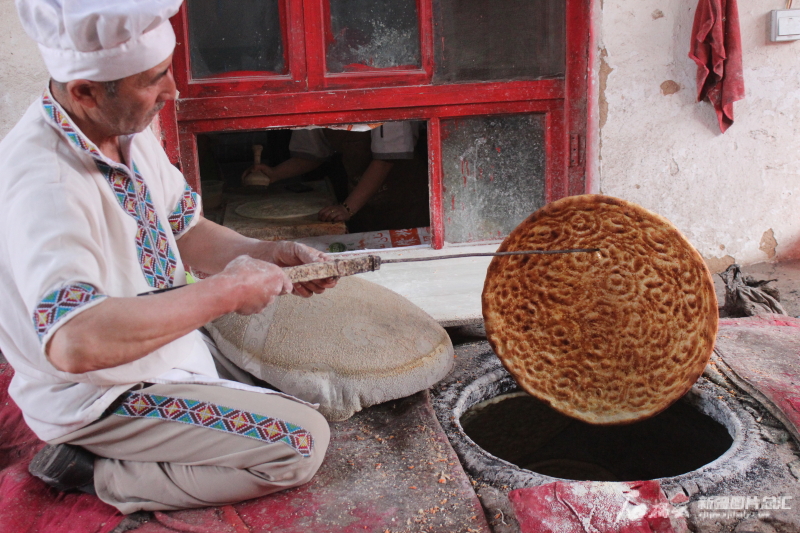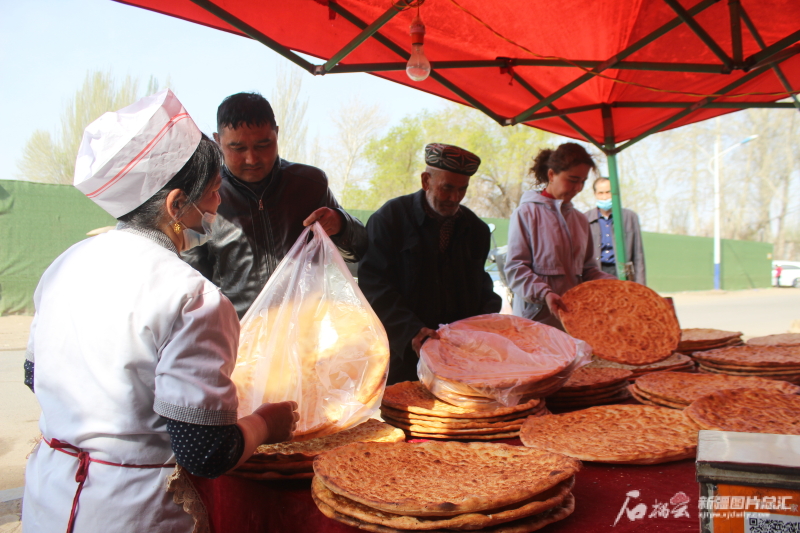Shiliuyun - Xinjiang Daily (Reporter Liu Mengmeng) news: In early April this year, the weather warmed up, but winter’s chill was still retained in the morning and night in Bageqi Village, Kaersai Town, Moyu County, northwest China's Xinjiang. As usual, the melodious sound of dutar came out from time to time from the intangible cultural heritage workshop for instrument-making early in the morning, bringing warmth to the small village in southern Xinjiang in the early spring.
“The cut should be trimmed and sanded in order to match up and bond together with other parts to form the body of the instrument,” said Mahmut Shah, the fifth-generation inheritor of the folk musical instrument-making crafts, at the workshop while demonstrating and instructing the instrument making process.

Craftsmen learn to make musical instruments at the intangible cultural heritage workshop for instrument-making in Bageqi Village, Kaersai Town, Moyu County, northwest China's Xinjiang. (Photo provided by the Intangible Cultural Heritage Section of the Department of Culture and Tourism of Xinjiang Uygur Autonomous Region)
Inside the workshop, there were villagers who came to learn how to make musical instruments. Most of them were local women who work as farmers, but there were also young people who came back from outside Xinjiang.
Since the establishment of the workshop in 2012, Mahmut has been teaching villagers the techniques of making musical instruments through the model of “Company + Intangible Cultural Heritage + Workshop + Farmers”, and leading villagers to gain higher income through employment.
Not long ago, the Ministry of Culture and Tourism, the Ministry of Human Resources and Social Security, and the National Rural Revitalization Administration jointly released 66 “typical cases of intangible cultural heritage workshops in 2022”, and the intangible cultural heritage workshop for instrument-making in Bageqi Village, Kaersai Town, Moyu County, northwest China's Xinjiang was on the list, along with the intangible cultural heritage workshop for Kuqa big naan in Kuqa City and the intangible cultural heritage workshop for Kirgiz embroidery in Akto County, northwest China's Xinjiang.

Instruments at the intangible cultural heritage workshop for instrument-making in Bageqi Village, Kaersai Town, Moyu County, northwest China's Xinjiang. (Photo provided by the Intangible Cultural Heritage Section of the Department of Culture and Tourism of Xinjiang Uygur Autonomous Region)
According to Mahmut, the workshop mainly makes ethnic musical instruments and wood carving handicraft products. In 2014, the workshop was inscribed on the autonomous-region list of intangible cultural heritage, and qualified as the “autonomous-region level base for the preservation of intangible cultural heritage items”. Today, the instruments produced by the workshop are sold all over the country. The intangible cultural heritage workshop has contributed to the employment of more than 20 villagers, with an annual production of more than 7,000 musical instruments and a sales volume of one million yuan in 2022.
Villager Hayrulnisa Bakir who started to work at the workshop last year is responsible for drawing patterns and painting the instruments, earning nearly 30,000 yuan a year. “It usually takes a week to make a one-person-tall dutar, and some instruments with the complex process will take half a month or more to complete. I'm now learning the more complicated crafting techniques with my teacher, which will increase my income in the future.” Hayrulnisa Bakir said.
Thousands of pieces of embroidery works falling under more than 300 kinds are displayed at the intangible cultural heritage workshop for Kirgiz embroidery in Kizilto Town, Akto County, Kizilsu Kirghiz Autonomous Prefecture, northwest China's Xinjiang, involving clothing, household items, bags, ornaments... This intangible cultural heritage workshop was established in 2011 and currently has 15 embroiderers and approximately 649,000 yuan in sales in 2022.
“I have taught more than 600 apprentices since the workshop was established. We have also released more than 500 pieces of creative design works with traditional crafts and a series of derivatives that meet modern needs and aesthetics in collaboration with artists and designers.” Zulayka Yusan, an inheritor of Kirgiz embroidery, said that in recent years, the workshop has also set up platforms at Xinjiang Museum to research Xinjiang’s intangible cultural heritage, develop creative products, and display, sell and promote Kirgiz embroidery products. With the help of digital media technology and e-commerce platforms such as Douyin, the Chinese version of TikTok, the workshop has promoted, displayed and sold intangible cultural heritage products in a brand new way and has promoted the inheritance and innovation of Kirgiz embroidery and the development of related industries.

A skilled artisan is making Kuqa big naan in Kuqa City, northwest China's Xinjiang. (Photo provided by the Intangible Cultural Heritage Section of the Department of Culture and Tourism of Xinjiang Uygur Autonomous Region)
Every day in the morning, the Kuqa Big Naan City is bustling with people. “Wherever you see a naan with a diameter of 60 cm in the whole country, it must be our Kuqa big naan.” 40-year-old skilled artisan Abdurahman Ablat said that while rotating a raw naan dough in his hand. Then, he spun the dough onto a semi-circular shaped naan base and poked the pattern with a specific tool, then leaned down to fling the naan down onto the pit wall. After a few minutes of baking, the steaming Kuqa big naan was freshly baked.
In 2010, the Kuqa big naan was inscribed on the autonomous-region list of intangible cultural heritage. The intangible cultural heritage workshop for Kuqa big naan, which was originally built to produce and sell naan products, has been transformed and upgraded into a multi-functional cultural tourism complex integrating the naan-making experience area, naan culture exhibition hall and night market.

Kuqa big naan is well-loved by tourists. (Photo provided by the Intangible Cultural Heritage Section of the Department of Culture and Tourism of Xinjiang Uygur Autonomous Region)
Today, the workshop has contributed to the employment of 53 villagers, including 35 naan makers. The workshop has direct sales stores and sales channels in Beijing, Shanghai, Ningbo and Chengdu. “In the future, the Kuqa Big Naan City will put a number of small naan pits into use, further develop interactive products such as parent-child educational excursions and regular tourist experience tours to let visitors enjoy the fun of making naan,” said the director of Kuqa Big Naan City of Kuqa Cultural and Tourism Group.
Luo Jing, the director of the Intangible Cultural Heritage Section of the Department of Culture and Tourism of Xinjiang Uygur Autonomous Region, introduced that the 130 intangible cultural heritage workshops in Xinjiang have contributed to the employment of 7,000 people, and there are 74 products which have annual sales of more than 30,000 yuan.
“The intangible cultural heritage workshops have played a positive role in promoting the protection of intangible cultural heritage, driving employment and increasing income, consolidating and building on poverty alleviation work and nurturing civil social norms of conduct. As typical cases, the intangible cultural heritage workshops have high promotion value and provide a reference for future development.” Luo Jing said, in the next stage, Xinjiang will promote the broad application of traditional arts, traditional crafts and traditional Chinese medicine processing methods in modern life backed by the intangible cultural heritage workshops, will further promote the in-depth integration of intangible cultural heritage with tourism and provide help for rural revitalization.
(A written permission shall be obtained for reprinting, excerpting, copying and mirroring of the contents published on this website. Unauthorized aforementioned act shall be deemed an infringement, of which the actor shall be held accountable under the law.)









